Back in the 70s, Advanced Dungeons & Dragons established the tradition of presenting the primary rules of the game in the form of the Player’s Handbook, Dungeon Master’s Guide, and Monster Manual, which is still continued to this day. Both by the official D&D brand and a large number of OGL games based on it. (The first game from 1974 also had three small books, but they were divided up differently and were sold as a single box set.) At the same time, the original Dungeons & Dragons got a new edition as well, released as the Basic Set in anticipation that there would be more sets to follow later on. The Expert Set followed four years later in 1981 (at the same time as a third edition of the Basic game), and from 1983 onward came the Companion, Master, and Immortals Sets set one year appart (with a fourth edition of the Basic Set). Each set added more character levels, spells for these higher levels, and also new monster. This was the same approach that was used for the first edition of the Dragon Age RPG a few years ago (though it now gets a second Editon where everything is in a single hardcover book).
I got the 1983 Basic and Expert Sets, as well as the 1991 Rules Cyclopedia, which contains most of the content from all five BECMI sets. Mostly the monsters are classic D&D critters like orcs, goblins, owlbears, rust monsters, gelatinous cubes, and so on. But there are also a couple of monsters that never made it into the AD&D line or were picked up by 3rd, 4th, and 5th edition (though there was one Mystara Monstrous Compendium for AD&D 2nd Edition), which are the ones I’ll be covering here.
Basic Set
Oh, right off to a good start: BECMI can rightfully be considered the Dad Joke edition of Dungeons & Dragons. Some people on the time really had a great fondness for them. The largest of the giant spiders in the Basic Set is the Tarantella. Maybe you are like me and think “Don’t you mean tarantula? Isn’t tarantella some kind of dance?” And yes, it is. The tarantella is a giant tarantula that has a special poison that does not kill but instead causes the victim to start dancing. It’s a magical poison and everyone who sees a poisoned person dancing must make a saving throw or also start to dance. After about an hour of dancing, they will collapse from exhaustion. *groan*
According to legend, the Thoul was inspired by a typo. The creature that was made from it is a magical crossbreed of a troll, a ghoul, and a hobgoblin. A thoul looks almost exactly like a hobgoblin, but has a paralyzing touch like a ghoul and regenreates 1 hit point every round like a troll. They are not terribly strong, but for 1st and 2nd level characters they might actually be quite mean and a lot more challenging than a regular hobgoblin. Nice boss for a 1st level dungeon crawl, I would say.
Expert Set
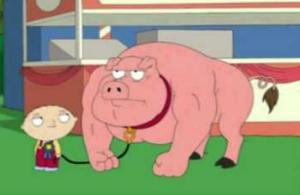
The Devil Swine is a special type of lycanthrope. It can change shape freely during the night, but stays in whichever form it had last taken during the day. It prefers to eat human flesh and at 9 HD is a really mean beast, much more dangerous than even werebears or weretigers. As a special ability, a devil swine can cast charm person three times per day and often is accompanied by a few human minions. Lawrence Schick confirmed to me that the devil swine is indeed based on the swine things from the novel The House on the Borderland which he and Tom Moldvay quite loved. And whose title should also sound quite familiar to long time D&D fans.
Not a new monster, but I think it’s interesting that the types of giants in the Expert Set are the same ones as in the 3rd Edition Monster Manual, while the Monstrous Manual of AD&D, on which the 3rd edition is primarily based, has a lot more varieties that never really made much of an appearance in the later editions.
The golems in the Expert Set are very different, though. None of the “classic” types are found here, instead we get two unusual and two unqiue variants. Wood golems and bone golems have shown up in many other places, while the bronze golem is a lesser variant of iron golems. The most unique of the four is the amber golem, which has the shape of a huge lion or tiger and can track any targets and even see invisible creatures. This one really could have been used a lot more.
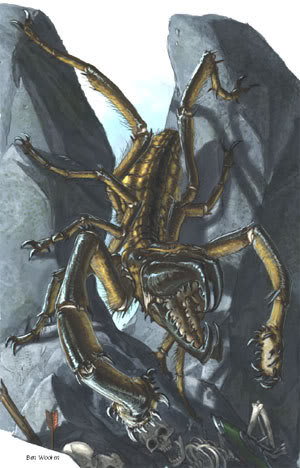
The Rhagodessa is something I’ve never heard of before now. The description is not very helpful and there is no picture in the Expert Set. However, it made an appearance in the Savage Tide adventure path from the Dungeon magazine, which takes largely place on the Isle of Dread from the Expert adventure module X1 The Isle of Dread, which was included in this version of the Expert Set. That’s where I got the picture from. The rhagodessa is a huge spider-like monster the size of a horse. They attack with their front legs, which do no damage, but keep the target in place to bite it with its massive jaws. Rhagodessas also only hunt in the dark. Hooray!
Rules Cyclopedia
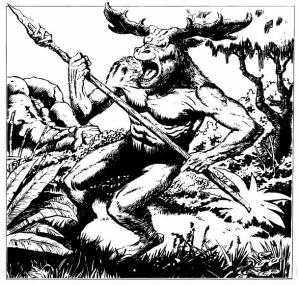
The Actaeon is a powerful protector of the forest. It appears like a humanoid giant with the head of an elk and is very strong and tough. Actaeons attack those who cause significant destruction to their forests and have the ability to summon other powerful creatures of the woods like bears, griffons, and treants. They also have a breath weapon that can turn enemies into harmless small forest critters forever. Even if they make their save they are transformed for 24 hours, which makes this ability extremely powerful. They also can make themselves invisible and are respected as leaders of the fey that inhabit their forest. They really remind me a lot of the demigod Cenarius from Warcraft III.
Snow Apes are somewhat intelligent Chaotic apes who eat almost anything, uncluding humans. They are very strong and almost invisible in snowy environment. (Evil Apes +1)
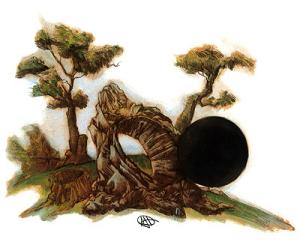
The Blackball is one of the really cool monsters of BECMI, though it hardly even qualifies as a creature. It’s a sphere of completely blackness one and a half meters in diameter, similar to a sphere of annihilation, that slowly drifts around aimlessly, disintegrating anything it comes into contact with. It has no mind or awareness, but when a creature comes within 20 meters, it will slowly start to drift in its direction and following it around until it comes into contact with it, or the creature moves outside that range. Since its relatively slow, it can be easily outrun in most situations, even underground and inside buildings. However, if one is found blocking a passage the players want to cross it can be quite a challenge to carefully draw it away without getting disintegrated. And they might suddenly pop out of a wall or approach unnoticed during a fight with other creatures.
Devilfish are a race of chaotic manta ray clerics. They also exist in AD&D, where they have a name that is both unpronouncable and unspellable, so I am really in favor of calling them devilfish. There also is a vampire devilfish variant. Devilfish leaders can be very powerful as clerics of 16th level. But then, this is the Known World where 30th level NPCs are not exactly rare. I always considered these both odd and also quite cool creatures. From what I now know about the Known World, it really doesn’t surprise me at all to find them here, and they probably first appeared in that setting.
A dragon shaped golem is called a Drolem. How creative. Stupid Pun Monsters +1?
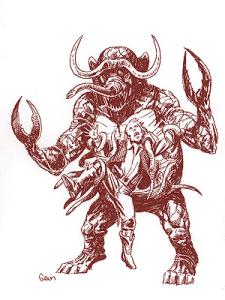
This image shows a Malfera. It’s some kind of demon from the Dimension of Nightmares, but other than the description what it looks like we’re only told that it can see invsible creatures and has a poisonous breath. It probably made sense in the adventure it appeared in.
